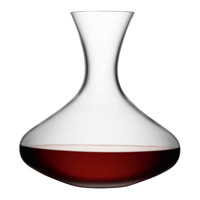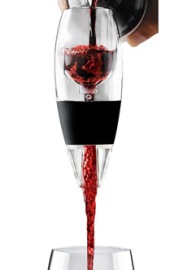So you’re a normal wine drinker. You know enough to be dangerous, knowing decanting is important since the sales person at your wine shop said so. Or maybe you just picked up the latest and coolest looking aerator that inserts in the bottle when you pour. You know it’s supposed to make the wine better, and it looks fancy, making it a fun conversation piece when using it with friends. But what really is decanting and aerating, whats the difference between them, and why and how do they work?
For the normal wine drinker, there are three basics methods to ensure your wine is the best it can be. Store and serve at the right temperature, decant and/or aerate your wine, and use the right style of glass to drink from. Miss one of these steps and the wine simply will not be the best it can be. Decanting and aeration is an important step for multiple reasons.
 Decanters, the typical wide bottomed glass cylinders we use today, were originally developed hundreds of years ago for a few reasons: to separate the natural sediment from the wine itself, to allow the wine to aerate naturally with air, and to hold the wine making it look good at a table, with a long neck easily handled by a servant. In modern times, the vast majority of wine is filtered, leaving you without the need to separate any sediment. Very old wines however often require manual separation, or decanting, when opened. This is why decanters often include an aeration funnel with a small mesh filter to pour through, the first initial step to filtering bits of cork and larger amounts of sediment.
Decanters, the typical wide bottomed glass cylinders we use today, were originally developed hundreds of years ago for a few reasons: to separate the natural sediment from the wine itself, to allow the wine to aerate naturally with air, and to hold the wine making it look good at a table, with a long neck easily handled by a servant. In modern times, the vast majority of wine is filtered, leaving you without the need to separate any sediment. Very old wines however often require manual separation, or decanting, when opened. This is why decanters often include an aeration funnel with a small mesh filter to pour through, the first initial step to filtering bits of cork and larger amounts of sediment.
 Aerating (airing) is the process where oxygen in the air reacts and stimulates the wine through direct contact. This allows the wine to ‘breathe’ or ‘open up’, allowing the natural tannins to soften releasing the wines bouquet and flavor, producing a wine that tastes less astringent and more complex than it would be right out of the bottle. Aeration is often used interchangeably with the word decanting by the general public since a decanter may be used to aerate a wine, even though technically decanting is the separation of sediment from the wine using a decanter.
Aerating (airing) is the process where oxygen in the air reacts and stimulates the wine through direct contact. This allows the wine to ‘breathe’ or ‘open up’, allowing the natural tannins to soften releasing the wines bouquet and flavor, producing a wine that tastes less astringent and more complex than it would be right out of the bottle. Aeration is often used interchangeably with the word decanting by the general public since a decanter may be used to aerate a wine, even though technically decanting is the separation of sediment from the wine using a decanter.
Aeration devices come in many forms. Typical counter-top decanters look fancy on a table, and allow the wine to slowly aerate over time. There are also other newer forms of ‘pour through’ aerators, either by insertion in the neck of the bottle or by simply holding the aerator itself over your glass while you pour through. These aerators maximize the wines ability to quickly breathe, oxidating it by infusing as much oxygen and air into the wine as possible allowing the wine to be drank right away.
So when do you decant and when do you aerate?
Decanting is simple….if you need to separate any sediment found inside your bottle, a decanter with a mesh filter is the obvious choice. Very high-quality expensive wines are often only half filtered, and any wine over 10 years old typically needs some kind of filtering. And now that you know what aeration is, you will understand this decanting process will also jump start the aeration of your wine. Be careful though when decanting an older wine since they almost always aerate and oxidize much quicker than a young wine!
Aerating, in general, is mostly important for young wines under 10 years old, which is why they have become so popular. These wines will almost always immediately improve in bouquet and flavor, and lets face it, we all mostly drink filtered wine that’s usually not more than 2-5 years old.
With wine, as almost all beverages, it’s a matter of personal taste and opinion. Experiment with different types of decanters, aerators and wines, and decide for yourself.
